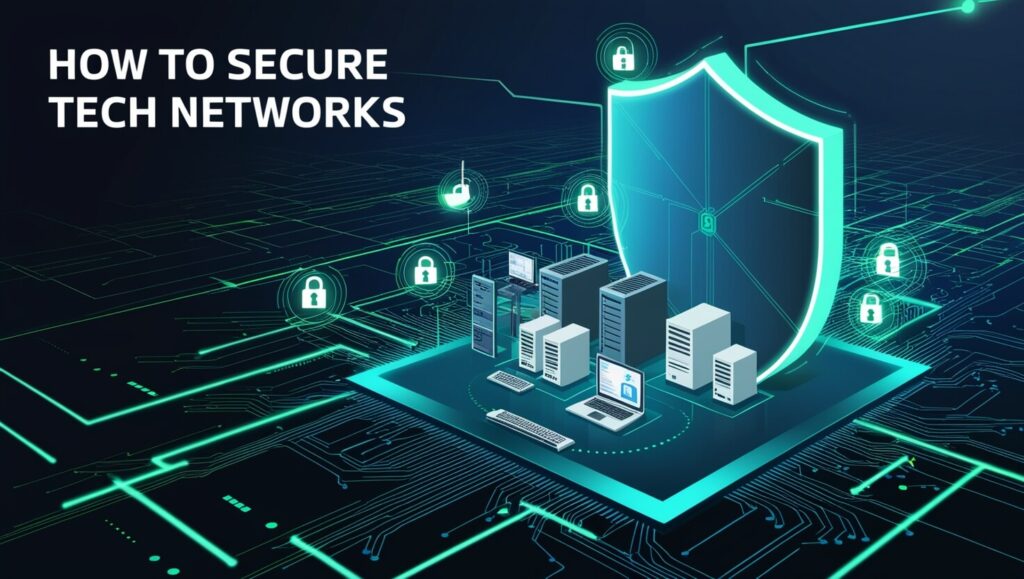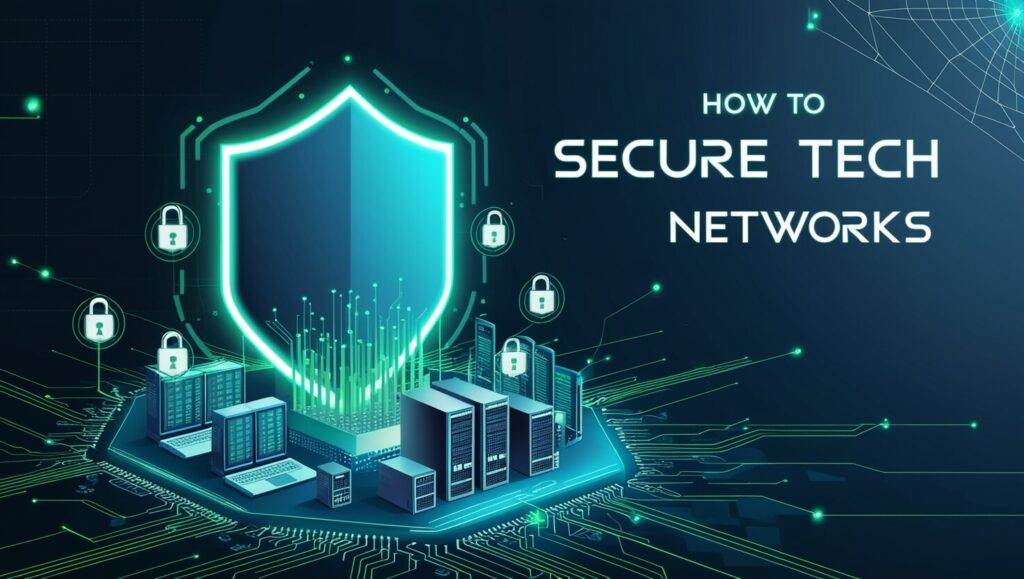In this article, I will discuss the How to Secure Tech Networks. Securing a network protects against cyber attacks, data breaches, and unauthorized access.
Adhering to basic security guidelines helps protect your digital infrastructure, sensitive information, and smooth business operations. Let’s look at practical measures to improve your tech network security.
What is Tech Networks?
Tech networks, or technology networks, refer to interrelated systems consisting of hardware, software, and digital tools that facilitate information exchange and communication both within and between organizational boundaries.

These networks encompass local area networks (LANs), wide area networks (WANs), cloud networks, as well as wireless networks. They underpin IT operations within an organization, enabling internet connectivity, data storage, application sharing, and cybersecurity, among others.
These networks should be managed and protected appropriately to safeguard sensitive information and ensure efficiency within organizational processes.
How to Secure Tech Networks

Example: Safeguarding a Decentralized Finance (DeFi) Platform
1Implement Strong Access Controls
Admin and developer accounts must undergo multi-factor authentication (MFA).
Access must be based on roles and permission levels as dictated by necessity.
Private keys must be safeguarded by hardware security modules (HSMs).
Ensure Network Encryption & Privacy
User and internal communications must employ end-to-end encryption.
Decentralized VPNs can avert data tracking as well as secure data transfers.
Users can be verified with distinguishing features to improve privacy via zero-knowledge proofs.
Monitoring & Threat Detection
AI-powered threat detection can expose risks within smart contracts.
Real-time supervision must be done using Intrusion Detection Systems (IDS).
Suspected activities across nodes should be monitored with log analysis tools.
Harden Infrastructure & Nodes
Maintain updated security patches for blockchain nodes and API interfaces.
Containerization keeps applications distinct to reduce attack vectors.
Distributed backups should be maintained to counteract security events.
Prepare Incident Response & Recovery Plan
Enhance risks using proactive vulnerability disclosures by establishing a bug bounty program.
Establish rapid rollback mechanisms to prevent smart contract failures.
Create disaster recovery protocols for security in decentralized storages.
Use Firewalls and Antivirus Protection
Employ Firewalls to Prevent Unauthorized Access
Firewalls are the first line of defense separating the internal network from external threats. Set them up to check incoming and outgoing communications, only permitting a select list of trusted participants.
Purchase an Antivirus Solution from a Reputable Vendor
Antivirus programs are essential for the detection and containment of malware (software that damages or disrupts system operations) including viruses, trojans, and ransomware. They act before any irreversible damage can be inflicted.
Enable Intrusion Detection and Prevention Systems (IDPS)
Use IDPS tools to supervise network traffic for any unusual activity and perform the necessary actions that can mitigate potential risks.
Update All Security Applications Periodically
Firewalls and antivirus tools ought to be updated regularly alongside the latest emerging security challenges either manually or automatically.
Encrypt Data and Communications
VPNs Should Be Used for Remote Access
A Virtual Private Network (VPN) protects internet traffic through encryption which guarantees a connection for remote workers and protects against data breaches.
Use SSL or TLS On Websites and Services
Sensitive information such as login information, payments, and personally identifiable information (PII) derive high protection from Secure Sockets Layer (SSL) and Transport Layer Security (TLS) which encrypts data throughout the processes between users and server.
Encrypt Sensitive Files and Databases
Customer records, sensitive files, financial data, and intellectual property need to be stored with meticulous protective measures using high encryption algorithms.
Automatically Enable End-to-End Encryption for Messaging
Only intended recipients should access written messages. This is possible through the use of other messaging platforms that support end-to-end encryption.
Monitor Network Activity

Employ Network Monitoring Systems
Track traffic and look for any strange or unusual traffic using tools like Wireshark, Nagios, or SolarWinds as well as checking for possible security violations.
Real-Time Alerts
Set alerts for suspicious activities like login failures, unusual data movement, and other access indicators out of the norm.
Regular Wireless Network Audits
Scheduled reviews of logs and network activity with the aim of exposes lapses within security as well as monitors adherence to security compliance policies.
Monitor All Devices with Access to the Network
All devices associated to a network must be continuously monitored to avoid possible internal unauthorized or externally unwanted devices.
Pros & Cons
| Pros | Cons |
|---|---|
| Protects sensitive data from cyberattacks | Can be costly to implement and maintain |
| Improves overall network performance | Requires ongoing monitoring and updates |
| Builds trust with clients and stakeholders | May limit access or convenience for some users |
| Reduces downtime and business disruptions | Employee training can be time-consuming |
| Ensures compliance with regulations | Complex setups may require skilled IT personnel |
Conclusion
In summary Securing technology networks is crucial in today’s world since cyber threat continue to evolve. Organizations can minimize breaches by implementing access controls, using firewalls and antivirus software, encrypting relevant information, and monitoring network activity.
Routine training sessions and a comprehensive response strategy enhance the defense. Safeguarding data improves breach prevention and business reputation. Critical data is shielded while protecting operational integrity and customer trust.










